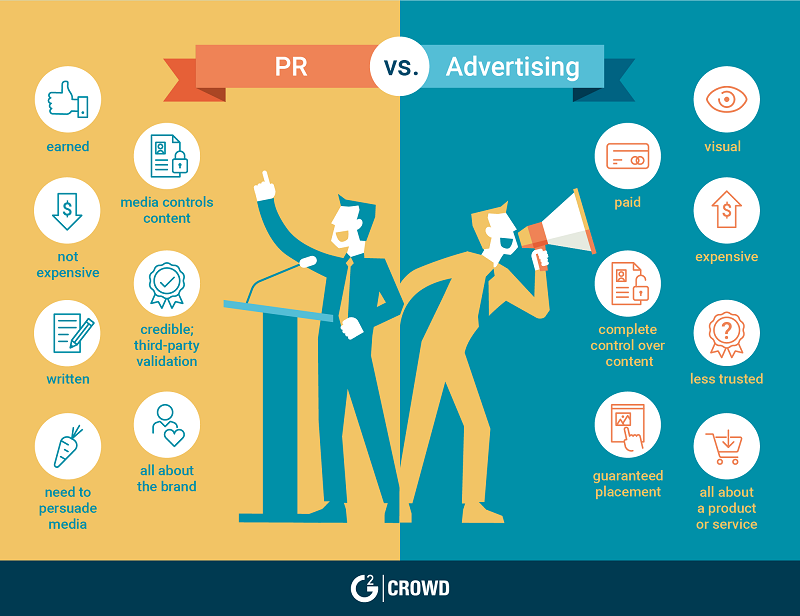PUBLIC RELATIONS (PR) VS. MARKETING: A COMPREHENSIVE COMPARISON
Introduction
Public Relations (PR) and Marketing are interrelated but distinct disciplines that contribute to a firm’s success. While they share similarities in communication and audience engagement, they differ in their goals, strategies and implementation. Here is a systematic discussion of their differences and similarities.
1. Definitions and Core Objectives
Public Relations (PR)
PR is the planned management of relationships between an organisation and its various stakeholders, comprising customers, employees, investors, media and the general public. The goal is to build a positive reputation and maintain goodwill (Grunig & Hunt, 1984). PR focuses on earned media and integrity through press releases, corporate communications, crisis management and media relations.
Example: When Apple launches a new iPhone, its PR team organises media events, distributes press releases and invites tech bloggers for early product reviews to generate organic media coverage.
Marketing
Marketing is the process of promoting and selling products or services, including market research, advertising and sales strategies (Kotler & Keller, 2016). The primary goal of marketing is to drive revenue by reaching potential customers through paid media, branding and promotional campaigns.
Example: Nike’s marketing team runs targeted digital advertisements, influencer campaigns, and sales promotions to encourage customers to buy the latest Air Jordans.
2. Key Differences Between PR and Marketing
| Feature | Public Relations (PR) | Marketing |
| Main Goal | Build and maintain reputation | Generate revenue and increase sales |
| Target Audience | Stakeholders (customers, media, investors, employees) | Customers and potential buyers |
| Communication Type | Two-way communication (relationship building) | One-way or two-way communication (persuasion & transactions) |
| Media Type | Earned media (press coverage, social proof) | Paid media (advertising, promotions) |
| Message Control | Limited (journalists/editors shape stories) | High (companies control messaging in ads) |
| Success Measurement | Brand sentiment, media coverage, public perception | Sales, customer acquisition, ROI (Return on Investment) |
3. Practical Examples of PR vs. Marketing in Action
Case Study 1: Tesla
Tesla’s PR Strategy:
- Elon Musk frequently uses Twitter to make announcements, generating media attention.
- PR teams manage Tesla’s image by promoting its sustainability mission.
- Earned media coverage from journalists and influencers deliberating on Tesla’s innovations.
Tesla’s Marketing Strategy:
- Tesla runs zero traditional advertising but relies on word-of-mouth marketing.
- Tesla uses referral programmes to incentivise customers.
- Tesla targets social media and email marketing to communicate directly with prospective buyers.
Key Takeaway: PR helps Tesla build an inventive, tech-savvy brand image, while marketing helps in driving its sales.
Case Study 2: McDonald’s
McDonald’s PR Strategy:
- Corporate social responsibility (CSR) initiatives such as reducing plastic waste.
- Managing public perception during controversies (e.g., food quality concerns).
- Press releases on new menu items or sustainability efforts.
McDonald’s Marketing Strategy:
- Running TV commercials, online advertisements and special promotions like “Buy One Get One Free” deals.
- Engaging in celebrity partnerships.
- Targeting specific demographics through personalised digital marketing.
Key Takeaway: PR ensures McDonald’s is seen as a reputable company, while marketing directly influences customer purchases.
4. Similarities Between PR and Marketing
Though PR and marketing have different roles, they share some similarities:
a. Both Aim to Build Brand Awareness: PR and marketing work together to ensure people recognise and trust a brand.
Example: Apple’s PR team builds enthusiasm through media coverage, whereas its marketing team runs advertising campaigns to convert interest into sales.
b. Both Use Storytelling to Engage Audiences: Compelling storytelling helps brands connect with customers and stakeholders emotionally.
Example: Nike’s marketing tells stories through commercials featuring athletes, while its PR team shares stories about corporate social responsibility (CSR) efforts, such as sustainability.
c. Both Leverage Digital and Social Media: Companies use social media platforms to amplify their messages in both PR and marketing.
Example: Coca-Cola uses PR for influencer collaborations (earned media) and marketing for targeted Facebook ads (paid media).
d. Both Influence Public Perception: PR and marketing work to maintain a positive brand image, even during crises.
Example: When a company faces a scandal, PR teams handle crisis communication, while marketing teams may adjust campaigns to divert focus from negative news.
5. How PR and Marketing Work Together
Effective brands integrate PR and marketing to maximise impact. A strong PR foundation enhances marketing effectiveness.
Example: Starbucks’ Sustainable Sourcing Strategy
- PR Tactic: Starbucks announces its sustainability initiative to source ethically grown coffee.
- Marketing Tactic: Starbucks runs social media ads showcasing its commitment to sustainability.
Result: Consumers have conviction in Starbucks’ brand values, leading to increased loyalty and sales.
6. Conclusion: When to Use PR vs. Marketing
| Scenario | Use PR | Use Marketing |
| Building long-term brand trust | ✅ | ❌ |
| Launching a new product | ✅ (Media coverage) | ✅ (Advertising & promotions) |
| Handling a crisis or reputation issue | ✅ | ❌ |
| Generating immediate sales | ❌ | ✅ |
| Engaging stakeholders (investors, employees, communities) | ✅ | ❌ |
Final Thoughts
PR and marketing are complementary, not competitive. While marketing focuses on sales and conversions, PR focuses on reputation and trust. Businesses that integrate both strategies achieve long-term success.
References
- Fill, C. (2013). Marketing Communications: Brands, Experiences, and Participation (6th ed.). Pearson.
- Grunig, J. E., & Hunt, T. (1984). Managing Public Relations. Holt, Rinehart, and Winston.
- Kotler, P., & Keller, K. L. (2016). Marketing Management (15th ed.). Pearson.
- Wilcox, D. L., Cameron, G. T., Reber, B. H., & Shin, J. H. (2015). Public Relations: Strategies and Tactics (11th ed.). Pearson.



